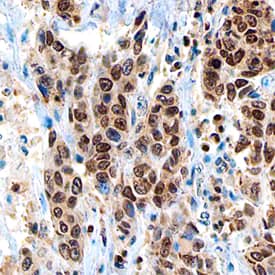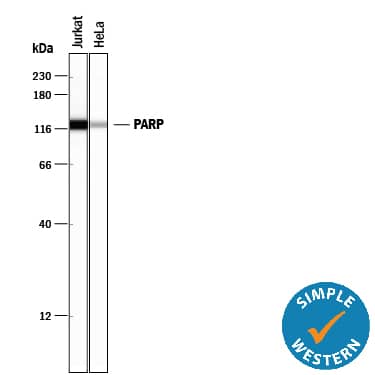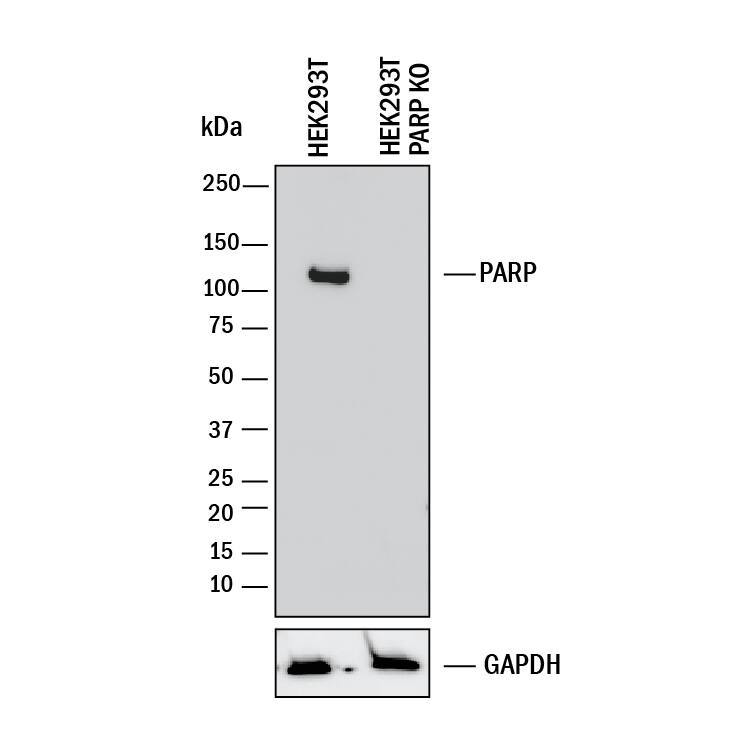Human PARP Antibody
R&D Systems, part of Bio-Techne | Catalog # MAB8095

Key Product Details
Validated by
Species Reactivity
Validated:
Cited:
Applications
Validated:
Cited:
Label
Antibody Source
Product Specifications
Immunogen
Thr373-Glu540
Accession # P09874
Specificity
Clonality
Host
Isotype
Scientific Data Images for Human PARP Antibody
Detection of Human PARP by Western Blot.
Western blot shows lysates of HeLa human cervical epithelial carcinoma cell line. PVDF membrane was probed with 1 µg/mL of Mouse Anti-Human PARP Monoclonal Antibody (Catalog # MAB8095) followed by HRP-conjugated Anti-Mouse IgG Secondary Antibody (Catalog # HAF018). A specific band was detected for PARP at approximately 110 kDa (as indicated). This experiment was conducted under reducing conditions and using Immunoblot Buffer Group 1.PARP in Human Breast.
PARP was detected in immersion fixed paraffin-embedded sections of human breast using Mouse Anti-Human PARP Monoclonal Antibody (Catalog # MAB8095) at 15 µg/mL overnight at 4 °C. Before incubation with the primary antibody, tissue was subjected to heat-induced epitope retrieval using Antigen Retrieval Reagent-Basic (Catalog # CTS013). Tissue was stained using the Anti-Mouse HRP-DAB Cell & Tissue Staining Kit (brown; Catalog # CTS002) and counterstained with hematoxylin (blue). Specific staining was localized to the nuclei of epithelial cells. View our protocol for Chromogenic IHC Staining of Paraffin-embedded Tissue Sections.Detection of Human PARP by Simple WesternTM.
Simple Western lane view shows lysates of Jurkat human acute T cell leukemia cell line and HeLa human cervical epithelial carcinoma cell line, loaded at 0.5 mg/mL. A specific band was detected for PARP at approximately 125 kDa (as indicated) using 10 µg/mL of Mouse Anti-Human PARP Monoclonal Antibody (Catalog # MAB8095). This experiment was conducted under reducing conditions and using the 12-230 kDa separation system.Applications for Human PARP Antibody
Immunohistochemistry
Sample: Immersion fixed paraffin-embedded sections of human breast
Knockout Validated
Simple Western
Sample: Jurkat human acute T cell leukemia cell line and HeLa human cervical epithelial carcinoma cell line
Western Blot
Sample: HeLa human cervical epithelial carcinoma cell line
Reviewed Applications
Read 1 review rated 5 using MAB8095 in the following applications:
Formulation, Preparation, and Storage
Purification
Reconstitution
Formulation
Shipping
Stability & Storage
- 12 months from date of receipt, -20 to -70 °C as supplied.
- 1 month, 2 to 8 °C under sterile conditions after reconstitution.
- 6 months, -20 to -70 °C under sterile conditions after reconstitution.
Background: PARP
PARP, Poly [ADP-ribose] polymerase 1 (PARP1), is a widely expressed component of a base excision repair (BER) complex, containing at least XRCC1, PARP2, POLB and LRIG3. PARP expression is correlated with proliferation, with higher levels occurring during early fetal development and organogenesis and in the highly proliferative cell compartments of adult. PARP is upregulated in B cells that have been induced to switch to various Ig isotypes. PARP interacts with the DNA polymerase alpha catalytic subunit POLA1; this interaction functions as part of the control of replication fork progression.
Long Name
Alternate Names
Gene Symbol
UniProt
Additional PARP Products
Product Documents for Human PARP Antibody
Product Specific Notices for Human PARP Antibody
For research use only



